Are you an artist—oil painter, singer, makeup artist, or writer ready to turn your passion into a profitable business?
If yes, and about to start your own art business; wait a moment!
You will need to think about resources and funding for navigating the ins and outs of an artistic journey.
Also, you need to specify if there’s a significant market for your business to be successful, what potential customers expect from you, and who are your competitors.
However, having a solid business plan is an essential tool to answer all these questions, and this artist business plan will surely help you!
It will guide you through all the important aspects of an effective artist business plan. It not only fuels your creativity but also paves the way for a sustainable and prosperous artistic venture.
But before diving right into the plan; let’s find some interesting facts about the creative art industry.

Free Business Plan Template
Download our free business plan template now and pave the way to success. Let’s turn your vision into an actionable strategy!
- Fill in the blanks – Outline
- Financial Tables
Creative Art Industry Outlook 2024
- The United States has been firmly holding its position as the leading global art market for the past few years, generating roughly 45% of the global sales value.
- The revenue of performing arts companies in the U.S. will amount to roughly $19,6 billion by 2024, while for independent artists, it will amount to approximately $23,1 billion.
- There are 71,828 people employed in the US musical groups and artists industry till 2023.
- The number of people increased 0.4% on average over the five years between 2018 and 2023.
- Zippia estimates that artists are 70% more likely to work at private companies as compared to public sectors.
Now, without further ado; let’s delve into the key components you need to include in your creative business plan.
Key Components of an Art Business Plan (w/ examples)
- Executive Summary
- Business Overview
- Market Analysis
- Product and Services
- Sales and Marketing Strategies
- Operations Plan
- Management Team
- Financial Plan
- Appendix
1. Executive Summary
An executive summary is the initial chapter intended to provide a quick overview of your entire artist business plan. It highlights the primary facts of your business, from art business ideas to financial projections.
Keep your summary concise and clear, use simple language, and avoid jargon as it quickly engages readers.
You can start by introducing the idea behind starting an art business and explaining what it does. For example, is it a startup, do you like to grow your business, or are you operating a chain of artist businesses?
Next, share a brief overview of how your art studio will be different from the rest. Provide a summary of each of the subsequent sections of your plan, such as:
- Describe the artist industry and the target market in brief.
- Represent the products or services you wish to offer.
- Give a snapshot of your marketing strategy.
- Name all the key members of your management team.
- Provide a summary of your financial projections.
After that, end your summary with a clear call to action, inviting potential investors or readers to the next meeting if they are curious about your business.
Generally, this section is written after the entire business plan is ready as you go through and draft all the important sections of your business plan.
Say goodbye to boring templates
Build your business plan faster and easier with AI
Plans starting from $7/month

2. Business Overview
The business overview section provides detailed information about your art business, including ownership, legal structure, office location, business history, and other business-related facts.
Initially, you can draft all the foundational facts like:
- The name of your art business and the concept behind it, for example: do you need a makeup artist business plan, music artist business plan, or painter business plan, and what is the actual idea behind your artist business?
- The legal structure of your art business whether it is a S-Corp, LLC, sole proprietorship, or some other.
- Location of your art gallery and the reason why you selected that place.
After that, describe the owners of your business and mention their roles in running it. Emphasize the percentage of shares owned, and how each owner helps in the business. For example,
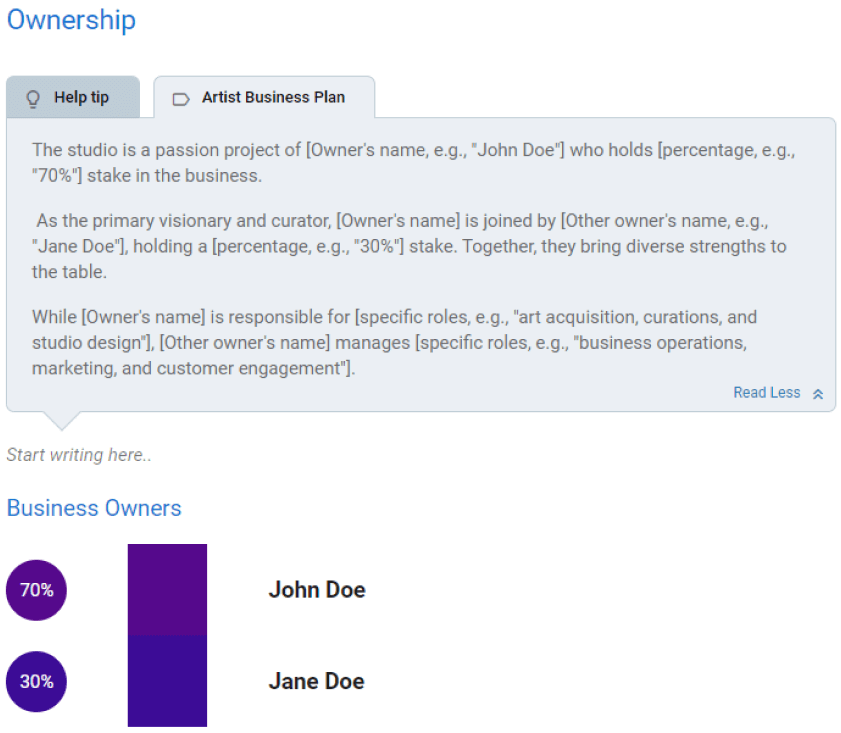
You can add a memorable, clear mission statement that sums up the objectives and core principles of your art studio. Also, include an outline of the business’s history and how it came to be in its current position.
If you want to, include some personality and interesting details, especially if you have any achievements or recognitions till now for your creative art.
Convey your aspirations and your clear vision. Highlight future business goals and if you have any plans of opening an art studio or hosting an art gallery opening.
3. Market Analysis
Next, dive into the art world as this chapter provides a clear understanding of the art industry, along with the target audience, competitors, and growth opportunities.
So, take some time to go further and identify your target market and define your ideal target customer. It will guide your artistic choices and marketing strategies.
Know more about your customers and which type of services they prefer: customized painting, greetings, invitation cards, poetries, songs, or anything else.
After that, give an overview of the art industry. It unveils necessary information about the market size and growth potential of the art market in which your business will run. :
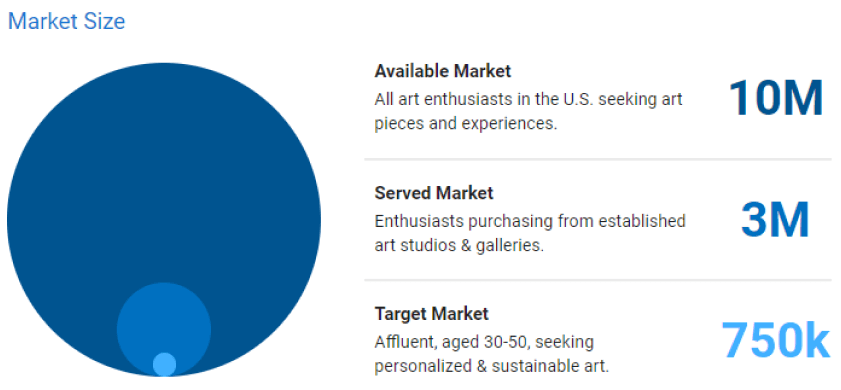
Also, conduct detailed market research to identify direct and indirect competitors. Evaluate their strengths and weaknesses.
You can perform a SWOT analysis to find internal strengths & weaknesses of your artist business and external opportunities & threats in the market.
Based on that, outline unique selling points and competitive edge. Accentuate how your art is different from the rest of the arts, and explain how you can offer qualitative services.
Try to analyze emerging market trends in the industry, such as changes in customer preferences and explain how your art business will cope with all those trends.
You can describe any regulations or licensing requirements that affect your art business, such as safety codes, contracts, taxes, or something else.
Here is an example you can refer to draft regulations for your art business:
Operating within the art industry entails adhering to several regulations.
These encompass [specific regulations, e.g., “safety codes for installation arts, contracts ensuring the rights and responsibilities of both artists and clients and taxation structures specific to art sales”].
Our studio is committed to upholding all necessary licenses and continuously stays updated on regulatory changes to ensure full compliance.
4. Product and Services
The product and services section of an art studio business plan should describe the specific services and products you will provide. It should be detailed, informative, and customer-focused.
Start this section by introducing the artist first, along with the art form they will be using, for example, paintings, sculpture, photography, sketches, customized services, greeting cards, or something else.
Describe the artist’s distinct aesthetic and style and explain how it distinguishes them from other professionals in the field.
You can also include the specific items the artist produces, such as their original works, sell paintings or their limited edition prints, or any pieces they have been commissioned to create.
Try to describe each product’s advantages and characteristics as well as how they appeal to the target market. Also, emphasize the importance of quality by including all the details about the raw material you will use.
Here, don’t forget to explain how your business will ensure that all services and products are delivered with the highest standards of efficacy.
5. Sales and Marketing Strategies
A successful sales and marketing plan involves a list of strategies you will use to attract and retain your potential customers.
Here are some key elements to include while writing your sales & marketing strategy:
Unique selling proposition (USP)
Clearly state the artist’s unique selling point, which should cover their taste, aesthetic, and the advantages of their products and services. Something needs to be said in a way that appeals to your intended audience.
Pricing strategy
Develop a pricing strategy that is competitive and affordable, yet profitable. Consider offering promotions, discounts, or packages for your products & services to attract new customers.
Marketing strategy
Draw out a marketing plan that can spread the word about your work and put yourself out there. You can include a mix of online and offline marketing channels.
Consider social media platforms, email marketing, content marketing, brochures, print marketing, and events.
You can take reference from the below example written using Upmetrics AI Assistant:
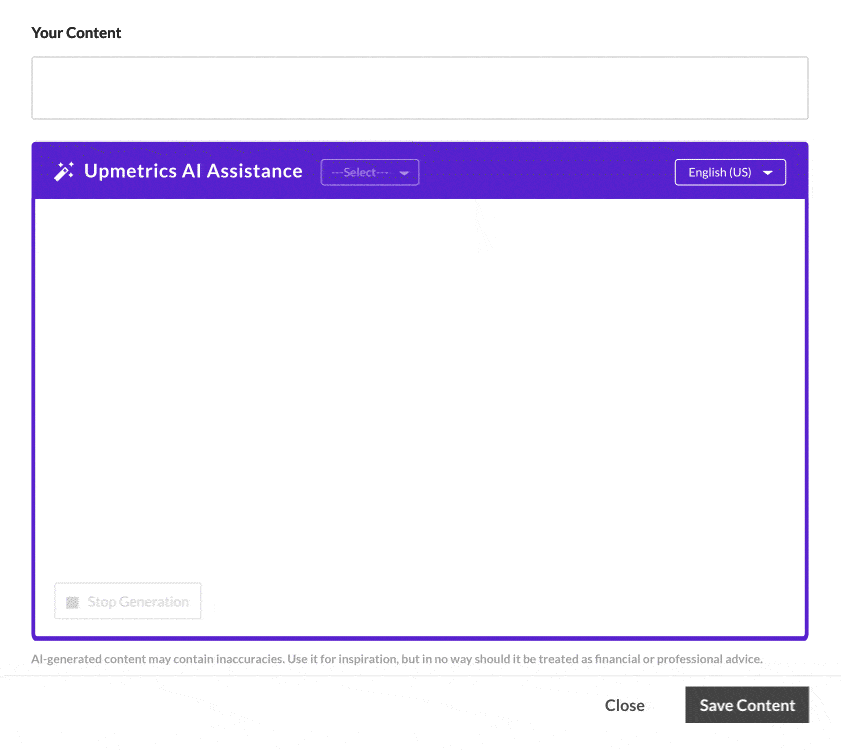
Sales strategies
Mention your sales strategy as an approach to turn potential buyers into clients by providing limited edition prints, discounts, and referral scheme discounts.
Customer retention
Describe how your art business will retain customers and build loyalty, such as through loyalty programs, special events, or personalized service.
6. Operations Plan
Next, you can craft a behind-the-scenes look into your artistic process and procedures.
This operations plan section paints a vivid picture of your creative endeavors, from your art studio setup to the tools and techniques you utilize.
First, you can explain how you go about creating your art, what tools and materials you require, and how long it takes to finish each piece.
If you collaborate with assistants or any other professional artist, provide details about their tasks and operational processes.
You can also describe your inventory management strategy, including your shipping, tracking, and storage methods. Mention how you’ll maintain track of your artwork and ensure that it’s transported and stored correctly.
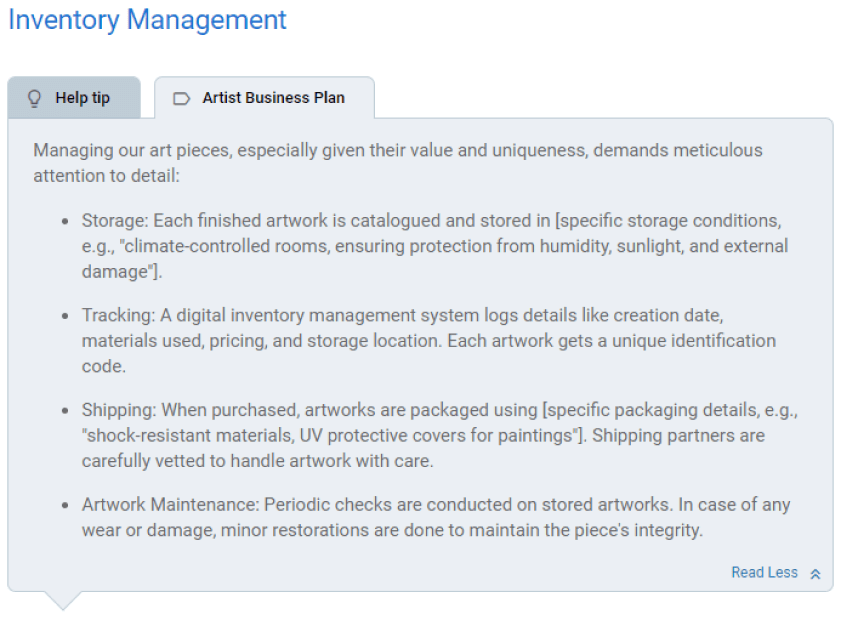
7. Management Team
The management team section provides a brief overview of the individuals responsible for driving the art business and highlights that your business has the most suitable team.
You can introduce your team members including the artist, the artist manager, the booking agent, the publicist, the accountant, and the lawyer.
Even if you’re an unaccompanied artist, showcase the key individuals who support your creative journey.
Try to provide a detailed description of the experience and qualifications of each manager, as well as their responsibilities and roles.
You can also represent the organizational structure of the management team, including reporting lines and how decisions will be made. Here is an illustration of an organization chart using Upmetrics:
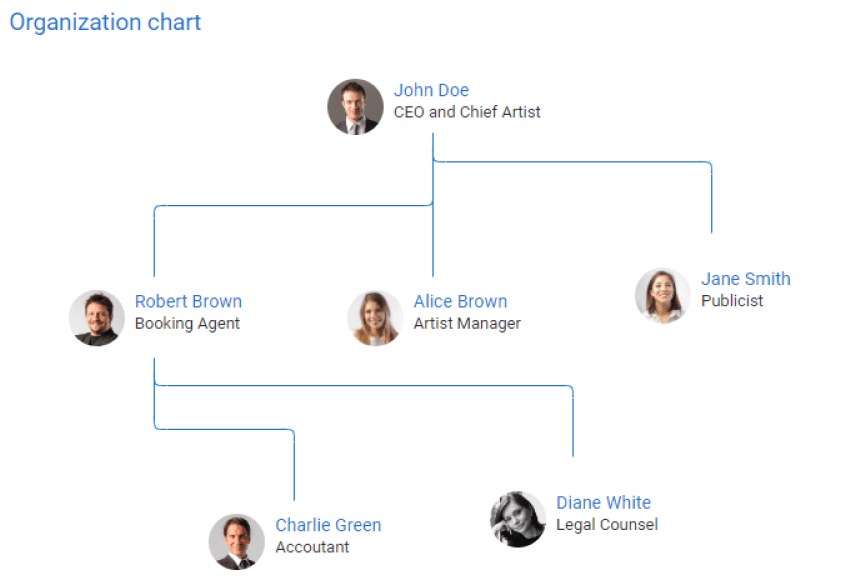
If you have a board of advisors/mentors who have contributed to your business growth, mention them along with their roles and experience.
Don’t forget to explain your compensation plan for the leadership team and staff, including salaries, bonuses, and other benefits.
8. Financial Plan
A well-structured and in-depth financial forecast is the most important section for potential investors, as it offers a clear insight into any capital or investment requirements, startup costs, projected revenues, and profits.
So, develop a precise summary of your financial projections for the initial years of operation. Highlight all the crucial facts investors require for informed, strategic decision-making.
For a successful artist business plan, you should include the following financial statements:
- Sales forecast
- Expense budget
- Profit and loss statement
- Cash flow statement
- Projected balance sheet
- Break-even analysis
- Business ratios
- Exit strategy
From the above, you can estimate how much finances you will need to start and operate your art business. Consider funding resources including bank loans, SBA-guaranteed loans, angel investors, or personal savings.
Here’s an example of a projected balance sheet for the next 3-5 years using Upmetrics:
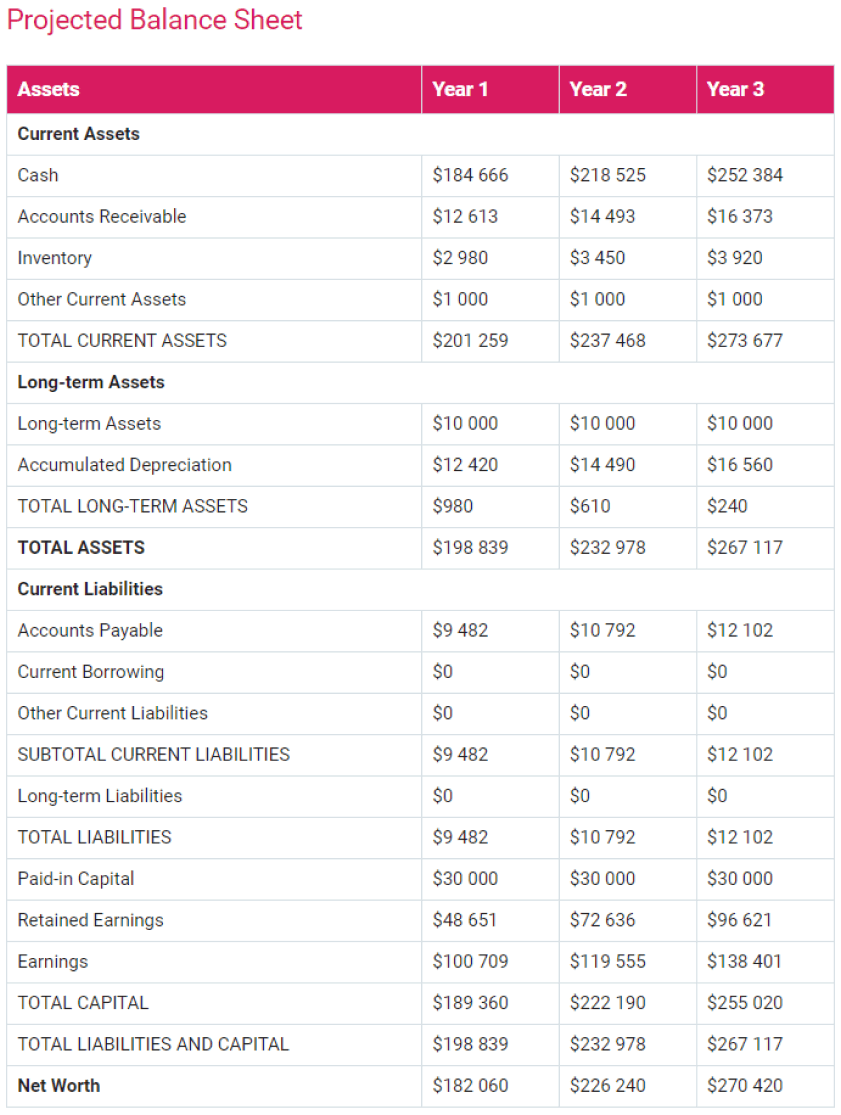
9. Appendix
When writing the appendix section, you should include any additional details that support the main content of your business plan.
This may include financial forecasts, market research data, legal documents, and other relevant information.
- Enclose a table of contents for the appendix section to make it easy for readers to find specific information.
- Add financial statements such as income statements, balance sheets, and cash flow statements. These should be up-to-date and show your financial projections for at least the first three years of your business.
- Provide market analysis reports, such as statistics on the size of the art industry, consumer demographics, and trends in the industry.
- Include any legal documents such as business licenses, permits, and contracts.
- Provide any additional documentation related to your business plans, such as marketing materials, product brochures, and operational procedures.
- Use clear headings and labels for each section of the appendix so that readers can easily locate the information they need.
The Quickest Way to turn a Business Idea into a Business Plan
Fill-in-the-blanks and automatic financials make it easy.
Business planning simplified with Upmetrics
With Upmetrics, you get easy-to-follow steps, customized business templates, 400+ examples of business plans, and AI support to make your business planning a lot simpler.
If you’re not good enough with financial formulas, Upmetrics helps you calculate accurate money forecasts for 3 years or more.
Whether you’re a beginner or trying to expand an existing one, Upmetrics is all you need to make a successful pro-business plan that matches your business goals.
Download our artist business plan pdf now and start writing a comprehensive plan in no time!





